Shawl Pins
It's hot here, I've been a slug. A little spinning in the mornings, then a lot of sitting in front of the cooler, sometimes knitting, sometimes dreaming of snow and ice. I hope by now everyone has seen An Inconvenient Truth. Frankly if this is the shape of things to come, I going to build a pool (hand me the shovel).
So, while knitting away, (on Kerry Blue shawl, in red, no pictures because just now it's a big red blob), I've been thinking of shawl pins. I like, and have used, the one I made for Fir Cone shawl (see this post), but this new shawl needs (interesting choice of word there) a new shawl pin (is the end result of all of this a pin for every shawl? yikes, oh, for the simple life: one shawl, one pin!). Anyway, thoughts turned to a spiral pin, and I began to plan.
I learned wire working from Celie Fago, in 1998. I would recommend her for any class ever, she's one of my idols. She teaches mostly polymer clay and PMC classes, which is reflected in her beautiful work.
I digress. In that first class, we learned to make jewelry components and findings. One of them was this necklace clasp:
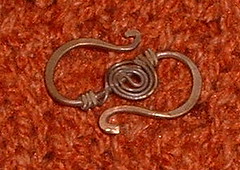
This is small, about an inch across, and was the inspiration for the first shawl pin. But the attached spiral, which Celie calls a Macedonian Spiral (I don't know why) is also a favorite of mine. What would this look like by itself, as a pin? Here is my rough sketch:

and here is the prototype in 18 ga. copper:

I planished the whole pin (hammered) over my bracelet mandrel (a curved piece of steel: my next jewelry teacher used a baseball bat instead), so it has a gentle curve, for the stick pin to slide through. I wanted to call it 3 Spirals, but the stick pin makes a 4th. So 4 Spiral shawl pin, it is.
Here is the process for making the pin. First, cut an 18" length of wire (this is 18 ga. red brass. I recommend 16 ga. but I had 18 ga. for the first two experiments). Fold the wire into two unequal parts:

I folded at 10", so one part was 8" and one part was 10" long. Then start bending the spiral, with the short leg on the outside:
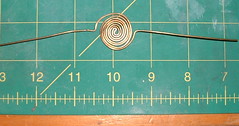
You will end up with a spiral with two ends sticking out opposite each other. Bend these into their own little spirals, planish and make the stick pin. After making the first few prototypes, I decided to make the ends a bit firmer, by making them into a wrapped loop, instead of spirals:
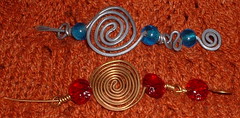
I added beads, at Cathy and Birdsong's suggestion. These were also planished on the bracelet mandrel, one is 18 ga. red brass, and the other is 16 ga. galvanized steel.
Then I decided to see what inspiration I could find for other shawl pins. I googled shawl pin , and came up with a list and found several sites on the first page to search. Many had what looked like hair clasps: geometric shapes, held by a stick or pin. But Joan McGowan-Michaels website had these which looked more like beaded kilt pins.
I have some pins like these on hand, from Fire Mountain Gems. They cost pennies (looks like it ranges from 25 cents to 40 cents a piece these days), and I'd bought a few packs for some other use long ago. Here they are:
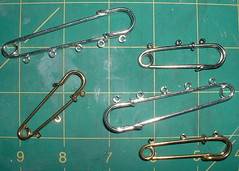
The obvious first step would be to just add beads to the loops provided:
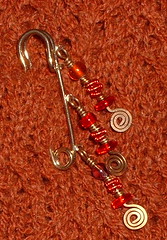
I also tried using wire to wrap beads on the pin, but the wire got too brittle to squeeze through the little loops, so I just cut them off. Then I had to file the sharp bits. I used a Dremel, with a bit that I use often for filing wire:

It's so well used, I have worn a wire size groove into it! Then it was simple to wrap some beads on the pin with finer gauge wire:

I looked closely at the pin itself, and decided I could just make one, then slip the beads on the back of it, like Joan's examples.
The first step: cut a length of wire, this time 16 ga. bright brass, 13" long. I folded 4" down:

then wrapped and planished the folded end:

I bent 2" around a mandrel for the top of the pin:

(note the mandrel: a sharpie pen). Then I wrapped the other end:
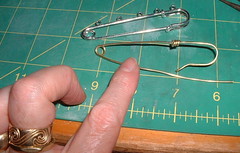
This still needs the pin part shortened, then planished and filed at the end. But wait: I forgot to slide the beads on the back (duh). Oops. So this one got beads wired on too:
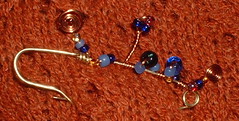
I made another, this time in 16 ga. copper, and made a smaller top (1 1/2" folded over, instead of 2"):
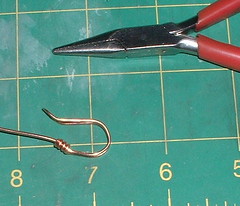
This time I remembered to add the beads before making the spring turn:
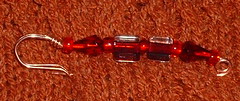
Wire working is simple, and requires very few tools: some pliers, a few mandrels (blocks of hardwood or steel plates) and some files. Any beginning class should get you enough skills to make all of these pins. If you are not interested in making them, lots of sites sell them: Joan's prices are very good, and there is as Etsy site with lots of cool wire and bead pins. Since I don't sell, I've given Yarngirl (Scotts Mountain Crafts Etsy shop) permission to reproduce these deigns for sale. If you have any questions, email me.
I made quite the collection in one day's experimenting:
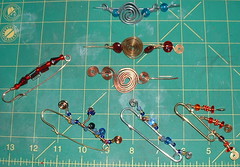
Now I need to get busy and knit (stops to count) seven more shawls!
So, while knitting away, (on Kerry Blue shawl, in red, no pictures because just now it's a big red blob), I've been thinking of shawl pins. I like, and have used, the one I made for Fir Cone shawl (see this post), but this new shawl needs (interesting choice of word there) a new shawl pin (is the end result of all of this a pin for every shawl? yikes, oh, for the simple life: one shawl, one pin!). Anyway, thoughts turned to a spiral pin, and I began to plan.
I learned wire working from Celie Fago, in 1998. I would recommend her for any class ever, she's one of my idols. She teaches mostly polymer clay and PMC classes, which is reflected in her beautiful work.
I digress. In that first class, we learned to make jewelry components and findings. One of them was this necklace clasp:

This is small, about an inch across, and was the inspiration for the first shawl pin. But the attached spiral, which Celie calls a Macedonian Spiral (I don't know why) is also a favorite of mine. What would this look like by itself, as a pin? Here is my rough sketch:

and here is the prototype in 18 ga. copper:

I planished the whole pin (hammered) over my bracelet mandrel (a curved piece of steel: my next jewelry teacher used a baseball bat instead), so it has a gentle curve, for the stick pin to slide through. I wanted to call it 3 Spirals, but the stick pin makes a 4th. So 4 Spiral shawl pin, it is.
Here is the process for making the pin. First, cut an 18" length of wire (this is 18 ga. red brass. I recommend 16 ga. but I had 18 ga. for the first two experiments). Fold the wire into two unequal parts:
I folded at 10", so one part was 8" and one part was 10" long. Then start bending the spiral, with the short leg on the outside:

You will end up with a spiral with two ends sticking out opposite each other. Bend these into their own little spirals, planish and make the stick pin. After making the first few prototypes, I decided to make the ends a bit firmer, by making them into a wrapped loop, instead of spirals:

I added beads, at Cathy and Birdsong's suggestion. These were also planished on the bracelet mandrel, one is 18 ga. red brass, and the other is 16 ga. galvanized steel.
Then I decided to see what inspiration I could find for other shawl pins. I googled shawl pin , and came up with a list and found several sites on the first page to search. Many had what looked like hair clasps: geometric shapes, held by a stick or pin. But Joan McGowan-Michaels website had these which looked more like beaded kilt pins.
I have some pins like these on hand, from Fire Mountain Gems. They cost pennies (looks like it ranges from 25 cents to 40 cents a piece these days), and I'd bought a few packs for some other use long ago. Here they are:

The obvious first step would be to just add beads to the loops provided:

I also tried using wire to wrap beads on the pin, but the wire got too brittle to squeeze through the little loops, so I just cut them off. Then I had to file the sharp bits. I used a Dremel, with a bit that I use often for filing wire:

It's so well used, I have worn a wire size groove into it! Then it was simple to wrap some beads on the pin with finer gauge wire:

I looked closely at the pin itself, and decided I could just make one, then slip the beads on the back of it, like Joan's examples.
The first step: cut a length of wire, this time 16 ga. bright brass, 13" long. I folded 4" down:

then wrapped and planished the folded end:

I bent 2" around a mandrel for the top of the pin:

(note the mandrel: a sharpie pen). Then I wrapped the other end:

This still needs the pin part shortened, then planished and filed at the end. But wait: I forgot to slide the beads on the back (duh). Oops. So this one got beads wired on too:

I made another, this time in 16 ga. copper, and made a smaller top (1 1/2" folded over, instead of 2"):

This time I remembered to add the beads before making the spring turn:

Wire working is simple, and requires very few tools: some pliers, a few mandrels (blocks of hardwood or steel plates) and some files. Any beginning class should get you enough skills to make all of these pins. If you are not interested in making them, lots of sites sell them: Joan's prices are very good, and there is as Etsy site with lots of cool wire and bead pins. Since I don't sell, I've given Yarngirl (Scotts Mountain Crafts Etsy shop) permission to reproduce these deigns for sale. If you have any questions, email me.
I made quite the collection in one day's experimenting:

Now I need to get busy and knit (stops to count) seven more shawls!

13 Comments:
Thank you so much! I cannot express in words how much your generosity means to me.
After our emails, I see this post. OMG, now I need to worry about shawl pins too. It's SO much easier hiding away at home. I love the first wrapped swirls that you beaded and the clasp. Lovely.
Wow, what a great tutorial to get us inspired about wire work - and DH already has all the stuff I need lying around (except the beads, which I have). The heat has me dispirited, though, and this might wait till winter. I'm with Deanna on ways to deal with the heat, although I favor drinking mojitos over sweetened iced tea, the southern favorite.
Your shawl pins are really pretty.
Wow, Sara. That's a great tutorial. Thank you.
And I have baseball bats! In fact, I probably have a 10-12 in the garage. Can you just use 18 gauge copper from the hardware store for sampling? I probaby should get a smaller hammer ....
Beautiful! Thank you so much for the tutorial too. Well done.
Sara, thanks for your very kind comments on my blog. Thanks for visiting! I was going to tell you a while ago that I thought that this metalwork was just the coolest thing....very Celtic you know! Very well done!
This comment has been removed by a blog administrator.
Fabulous shawl pins, eh Sara. Never thought to wear mine to the St. Catherine's conference. Have you been cooking up a project that involves silk/cashmere/camel & yak? Loving seeing the photo of you wearing your gorgeous Peacock Feather's Shawl. I kick myself for not piping up during your keynote address to let people know that you knit it! Sometimes i am just not on the ball, eh!
Thank you for this tutorial. I may have to learn how to planish just so I can make myself one.
This comment has been removed by a blog administrator.
This comment has been removed by a blog administrator.
This comment has been removed by a blog administrator.
Post a Comment
<< Home